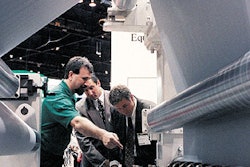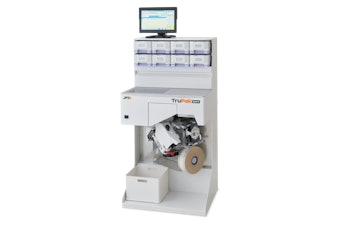PW: Meredith-Springfield is a plastic molder of technical hollow containers and custom bottles. How does Eastman Chemical’s Eastar Copolyester MB002 resin help your company extrusion/blow-mold the Artegraft tubes?
O’Leary: PET was the obvious choice of resin because it has great clarity and other physical properties supportive of the needs of this application. While PET is largely stretch/blow-molded, the most practical way to mold Artegraft’s tube with its particular cross section and length was extrusion/blow-molding. Eastman’s resin is specifically designed for extrusion/blow-molding. It is more like an engineering resin that accommodates specific equipment requirements and a narrower processing window as compared to resins like HDPE or PVC. The 20-inch-plus length of the tube makes it a challenge.
PW: Describe the extrusion/blow-molding process on the equipment used for the Artegraft tubes.
O’Leary: We receive Eastman’s resin in pellet form, in 1,400-lb Gaylord boxes. Vacuum draws resin from the box into a desiccant dryer. PET is very hydroscopic and must be dried to a -40ºF dew point. From the drier, the material is vacuum-loaded into an extruder hopper that keeps the material dry and warm. The plastic pellets fall by gravity to the extruder screw and are melted. At the end of the extruder is a die head. The tooling in the die head forms the hot taffy-like plastic mass coming off the screw into a centerless tube called a parison. The parison free falls out of the die head. The process is continuous, so the parison never stops coming out. The mold is shuttled back and forth from under the die head, where it captures a length of parison and then transfers away from the die head to the blowing position. A pin is inserted into the tube and compressed air from this pin blows the hot plastic out into contact with the metal mold cavity. The mold is a reverse of the Artegraft tube. The mold is refrigerated to rapidly cool the plastic and stabilize the shape and dimensions of the blown tube. The mold opens and drops out a molding and then shuttles back to get another parison. This process is repeated in an ongoing, automatic cycle.
PW: What are the specific molding challenges with Artegraft’s long tube?
O’Leary: Extrusion/blow-molding requires the parison to exit the die head, then be captured by the mold before the effects of gravity overtake the melt strength of the plastic. With a long part, gravity becomes an even greater factor.
PW: Was new equipment necessary for this job? If so, whose machinery does the molding?
O’Leary: We use a Bekum H155 Continuous-Extrusion Twin Shuttle blow-molding machine that we bought a few years ago. It uses an 80-mm extruder screw we had made specifically for running Eastman’s EB062 rein, a non-medical packaging version of the MB002. We added proprietary hardware and processing aids that enable us to overcome some of the gravity problems presented by working with a very long parison, with an engineering material having a low intrinsic viscosity. That, and a very precise parison program, in which we use every bit of the machine’s 100-point programming system, enable us deliver a uniform wall thickness over the entire length of the Artegraft part.
PW: Beyond the long parison, what makes the Artegraft molding project particularly interesting and challenging?
O’Leary: Although it’s a relatively low-volume [project], it’s a technically demanding job. We love working “out of the box” as long as the customer is committed to the financial support for development and the product has value warranting a premium part cost. We know of nothing like this tube ever having been attempted before of this size and shape. Also, MB002 is a relatively new resin. It was a natural for us, with our breadth of experience with Eastman’s EB062, and our prior expertise with long, thin, technical parts.
PW: What are the dimensions of the tube you make for Artegraft? How did you work with Artegraft and mold designer and manufacturer FGH Systems Inc. on this project?
O’Leary: The finished Artegraft tube is about 22” long x 11⁄2” wide, with a flat side. The neck is special, but much like a 28-415 finish. All the dimensions of the original round, glass tube Artegraft used before switching to the Eastar copolyester were adjusted to make the plastic tube more practical and blow moldable. FGH Systems did a great job of guiding the design together with Artegraft, their partner O.Berk, and Eastman. Most of the design and mold issues were settled by the time Meredith-Springfield got involved. FGH had blown a few prototypes from the mold and it was determined the production parts needed refinement in terms of weight, plastic distribution, and uniformity of wall thickness. We developed the production process and provided the expertise to remove those barriers to success.
PW: What do you see as the key properties of the Eastar material in terms of how it benefits Artegraft?
O’Leary: The Eastman resin provided the vehicle to move Artegraft out of glass, where breakage was a problem. The resin already had Food and Drug Administration medical approval and was suited for extrusion/blow-molding.
PW: What were the production deadline challenges Meredith-Springfield faced on this job and how did it meet them?
O’Leary: Eastman expedited manufacturing and logistics to enable us to get sufficient quantities of the resin faster than their normal lead times. We have ongoing support and communication with Eastman on a number of projects and they are always responsive when fast-tracking support for developments is critical to the success of the project. An aggressive timeline was established by Artegraft and agreed to by all parties. The developments and pilot production runs and FDA approvals all had to hit at specific dates in order to enable a timely conversion from the glass to plastic in Artegraft’s manufacturing process. The orchestration by O.Berk of the communication between the parties involved in this project was essential and as challenging as doing the work. But everyone was committed to getting it done on time. And it was!




















